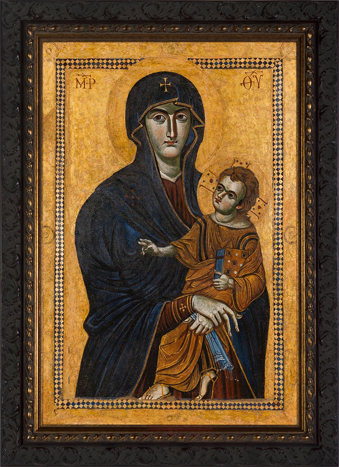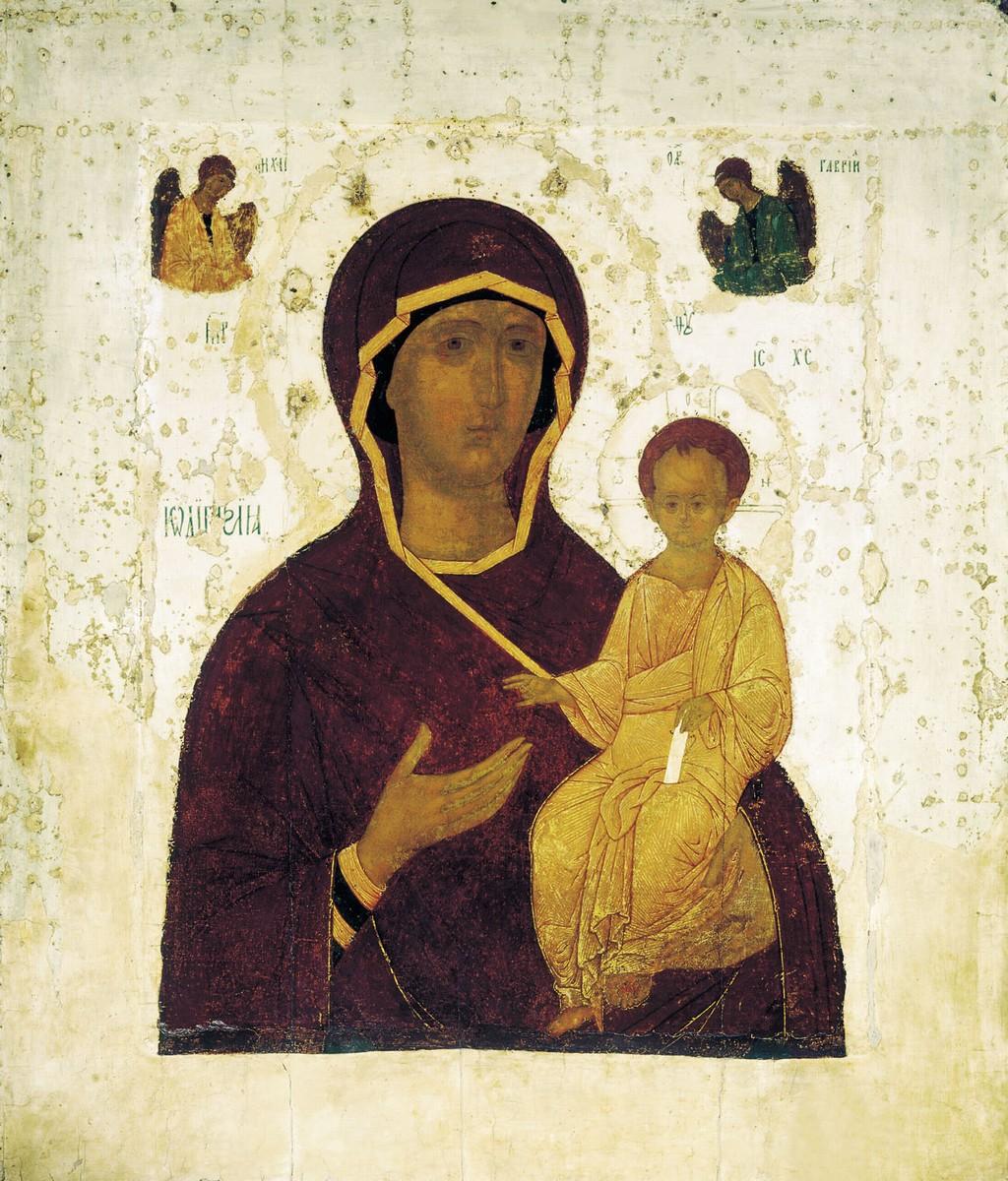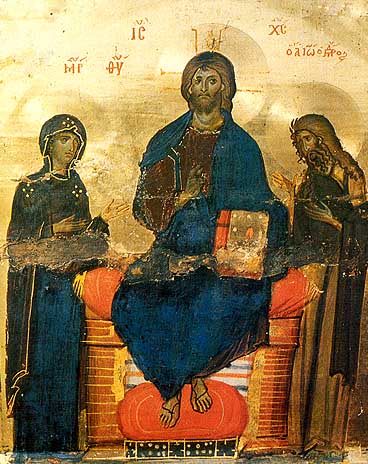|
Virgin Advocate
The Panagia Agiosoritissa or Hagiosoritissa (Greek: Ἁγιοσορίτισσα) is the name for a type of Marian icon, showing Mary without child, slightly from the side with both hands raised in prayer. The type is known in Latin as Maria Advocata. Names The names used for the icon, ''Hagiosoritissa'' and, in Russian, ''Khalkopratiskaya'' (Халкопратийская), derive from the church of the Holy Urn (Greek: Ἁγία Σορός, in reference to the urn containing the Cincture of the Theotokos) in Constantinople's Chalkoprateia (Χαλκοπρατεῖα, "copper market") district. In English, the type is also known as ''Madonna Advocate'' (the prayer gesture interpreted as an act of intercession on behalf of the faithful). History The appellation Ἁγιοσορίτισσα is first recorded in Byzantine seals of the 11th century, and it appears minted on coins made under Manuel I Komnenos (). The type was widespread in the Byzantine empire and in the Balkans, ... [...More Info...] [...Related Items...] OR: [Wikipedia] [Google] [Baidu] |
Maria Advocata (Madonna Del Rosario)
The ''Madonna del Rosario'' is an icon of Mary, mother of Jesus, Mary commonly dated to the sixth century or earlier.Belting (tr. Jephcott) 1994, p. 315. It is an early version of a type of icon known as the ''Agiosoritissa'' or the ''Maria Advocata'', in which Mary is depicted without the Christ Child, with both hands raised. The work, which has been kept in the Madonna del Rosario (Rome), Church of the Madonna del Rosario since 1931, is thought to be the oldest image of Mary in Rome, Italy. Medieval tradition held that the icon was composed by Icon#Luke's portrait of Mary, Luke the Evangelist himself. The painting is known by various names. It is often simply called ''Maria Advocata'', since it was long the only example of the type in Rome. It has also been referred to according to the various churches where it has resided, as ''Madonna in Tempulo'', ''Madonna di San Sisto Vecchio, San Sisto'', ''Madonna di Santi Domenico e Sisto'', or, as it is called here, ''Madonna del Ros ... [...More Info...] [...Related Items...] OR: [Wikipedia] [Google] [Baidu] |
Santi Bonifacio Ed Alessio
The Basilica dei Santi Bonifacio e(d) Alessio is a basilica, rectory church served by the Somaschans, and titular church for a cardinal-priest on the Aventine Hill in the third prefecture of central Rome, Italy. It is dedicated to Saint Boniface of Tarsus and (originally only) Saint Alexius. It lies on Piazza Sant’Alessio 23, near the historical gardens of St. Alexius and Via di santa Sabina. Basilica Founded between the 3rd and 4th centuries, it was restored in 1216 by Pope Honorius III (some columns of his building survive in the present building's eastern apse); in 1582; in 1743 designed by Giovanni Battista Nolli and in the 1750s reelaborated by Tommaso De Marchis (his main altar survives); and between 1852 and 1860 by the Somaschi, which congregation still serves it as a rectory church. The 16th century style facade, elaborated from the De Marchis phase, is built onto the medieval-style quadriportico. The church has a Romanesque campanile. On the south side of the ... [...More Info...] [...Related Items...] OR: [Wikipedia] [Google] [Baidu] |
7th-century Works
The 7th century is the period from 601 (DCI) through 700 ( DCC) in accordance with the Julian calendar in the Common Era. The spread of Islam and the Muslim conquests began with the unification of Arabia by Muhammad starting in 622. After Muhammad's death in 632, Islam expanded beyond the Arabian Peninsula under the Rashidun Caliphate (632–661) and the Umayyad Caliphate (661–750). The Muslim conquest of Persia in the 7th century led to the downfall of the Sasanian Empire. Also conquered during the 7th century were Syria, Palestine, Armenia, Egypt, and North Africa. The Byzantine Empire suffered setbacks during the rapid expansion of the Caliphate, a mass incursion of Slavs in the Balkans which reduced its territorial limits. The decisive victory at the Siege of Constantinople in the 670s led the empire to retain Asia Minor which assured the existence of the empire. In the Iberian Peninsula, the 7th century was known as the ''Siglo de Concilios'' (century of councils) refer ... [...More Info...] [...Related Items...] OR: [Wikipedia] [Google] [Baidu] |
Salus Populi Romani
''Salus Populi Romani'' (''Protectress'', or more literally ''health'' or ''salvation'', ''of the Roman People'') is a Roman Catholic title associated with the venerated image of the Blessed Virgin Mary in Rome. This Byzantine art, Byzantine icon of the Mary, mother of Jesus, Madonna and Child Jesus holding a Gospel book on a gold ground, now heavily Overpainting, overpainted, is kept in the Borghese (Pauline) Chapel of the Basilica of Saint Mary Major.''Relics'' by Joan Carroll Cruz 1984 page 96 The image arrived in Rome in 590 A.D. during the reign of Pope Gregory I. Pope Gregory XVI granted the image a canonical coronation on 15 August 1838 through the papal bull ''Cælestis Regina''. Pope Pius XII crowned the image again and ordered a public religious procession during the Marian year of 1 November 1954. The image was cleaned and restored by the Vatican Museum, then given a Pontifical Mass on 28 January 2018. The phrase ''Salus Populi Romani'' goes back to the legal syst ... [...More Info...] [...Related Items...] OR: [Wikipedia] [Google] [Baidu] |
Hodegetria
A Hodegetria , ; russian: Одиги́трия, Odigítria ; Romanian: Hodighitria, or Virgin Hodegetria, is an iconographic depiction of the Theotokos (Virgin Mary) holding the Child Jesus at her side while pointing to him as the source of salvation for humankind. The Virgin's head usually inclines towards the child, who raises his hand in a blessing gesture. In the Western Church this type of icon is sometimes called Our Lady of the Way. The most venerated icon of the Hodegetria type, regarded as the original, was displayed in the Monastery of the Panaghia Hodegetria in Constantinople, which was built specially to contain it. Unlike most later copies it showed the Theotokos standing full-length. It was said to have been brought back from the Holy Land by Eudocia, the wife of emperor Theodosius II (408–450), and to have been painted by Saint Luke the apostle himself. The icon was double-sided, with a crucifixion on the other side, and was "perhaps the most prominent ... [...More Info...] [...Related Items...] OR: [Wikipedia] [Google] [Baidu] |
Deesis
In Byzantine art, and in later Eastern Orthodox art generally, the Deësis or Deisis (, ; el, δέησις, "prayer" or "supplication"), is a traditional iconic representation of Christ in Majesty or Christ Pantocrator: enthroned, carrying a book, and flanked by the Virgin Mary and St. John the Baptist, and sometimes other saints and angels. Mary and John, and any other figures, are shown facing towards Christ with their hands raised in supplication on behalf of humanity. Early examples often appeared on the templon beam in Orthodox churches or above doors, though icons and devotional ivories also feature the Deesis. After the development of the full iconostasis screen there was room for a larger "Deesis row" or "Great Deesis" of full-length figures, and the number of figures expanded, both in Byzantium and in Russia. Usually this row is above the level of the doors, and usually below (sometimes above) the row depicting the Twelve Great Feasts. The central Christ is the ... [...More Info...] [...Related Items...] OR: [Wikipedia] [Google] [Baidu] |
Blachernitissa
Blachernitissa ( el, Βλαχερνίτισσα), also called Theotokos of Blachernae (Θεοτόκος των Βλαχερνών, Θεοτόκος η Βλαχερνίτισσα) or Our Lady of Blachernae (Παναγία η Βλαχερνίτισσα), is a 7th-century encaustic icon representing the ''Most Holy Theotokos and Ever-Virgin Mary''. It is also the name given to the Church built in honour of the Virgin Mary in the Blachernae section of Constantinople. The name Blachernae possibly derived from the name of a Vlach (sometimes written as Blach or Blasi), who came to Constantinople from the lower Danube. Byzantine palladium The Theotokos was considered to be the intercessory protectress ''par excellence'' of Constantinople and, indeed, of the entire Eastern Roman Empire (called "Byzantium" by some modern Western scholars). ''Blachernitissa'' is unusual among Orthodox icons in that it is not flat, but is formed in bas relief. According to Sacred Tradition, the icon ... [...More Info...] [...Related Items...] OR: [Wikipedia] [Google] [Baidu] |
Byzantine Dress
Byzantine dress changed considerably over the thousand years of the Empire, but was essentially conservative. Popularly, Byzantine dress remained attached to its classical Greek roots with most changes and different styles being evidenced in the upper strata of Byzantine society always with a touch of the Hellenic environment. The Byzantines liked colour and pattern, and made and exported very richly patterned cloth, especially Byzantine silk, woven and embroidered for the upper classes, and resist-dyed and printed for the lower. A different border or trimming round the edges was very common, and many single stripes down the body or around the upper arm are seen, often denoting class or rank. Taste for the middle and upper classes followed the latest fashions at the Imperial Court. As in the West during the Middle Ages, clothing was very expensive for the poor, who probably wore the same well-worn clothes nearly all the time;Payne, Blanche; Winakor, Geitel; Farrell-Beck Jane: ' ... [...More Info...] [...Related Items...] OR: [Wikipedia] [Google] [Baidu] |
Cloisonné
Cloisonné () is an ancient technique for decorating metalwork objects with colored material held in place or separated by metal strips or wire, normally of gold. In recent centuries, vitreous enamel has been used, but inlays of cut gemstones, glass and other materials were also used during older periods; indeed cloisonné enamel very probably began as an easier imitation of cloisonné work using gems. The resulting objects can also be called cloisonné. The decoration is formed by first adding compartments (''cloisons'' in French) to the metal object by soldering or affixing silver or gold as wires or thin strips placed on their edges. These remain visible in the finished piece, separating the different compartments of the enamel or inlays, which are often of several colors. Cloisonné enamel objects are worked on with enamel powder made into a paste, which then needs to be fired in a kiln. If gemstones or colored glass are used, the pieces need to be cut or ground into the sh ... [...More Info...] [...Related Items...] OR: [Wikipedia] [Google] [Baidu] |
Reliquary
A reliquary (also referred to as a ''shrine'', by the French term ''châsse'', and historically including ''wikt:phylactery, phylacteries'') is a container for relics. A portable reliquary may be called a ''fereter'', and a chapel in which it is housed a ''feretory''. Relics may be the purported or actual physical remains of saints, such as bones, pieces of clothing, or some object associated with saints or other religious figures. The authenticity of any given relic is often a matter of debate; it is for that reason, some churches require documentation of the relic's provenance. Relics have long been important to Buddhism, Buddhists, Christianity, Christians, Hinduism, Hindus and to followers of many other religions. In these cultures, reliquaries are often presented in shrines, churches, or temples to which the faithful make pilgrimages in order to gain blessings. The term is sometimes used loosely of containers for the body parts of non-religious figures; in particular the ... [...More Info...] [...Related Items...] OR: [Wikipedia] [Google] [Baidu] |
Vitreous Enamel
Vitreous enamel, also called porcelain enamel, is a material made by fusing powdered glass to a substrate by firing, usually between . The powder melts, flows, and then hardens to a smooth, durable vitreous coating. The word comes from the Latin , meaning "glass". Enamel can be used on metal, glass, ceramics, stone, or any material that will withstand the fusing temperature. In technical terms fired enamelware is an integrated layered composite of glass and another material (or more glass). The term "enamel" is most often restricted to work on metal, which is the subject of this article. Essentially the same technique used with other bases is known by different terms: on glass as ''enamelled glass'', or "painted glass", and on pottery it is called ''overglaze decoration'', "overglaze enamels" or "enamelling". The craft is called "enamelling", the artists "enamellers" and the objects produced can be called "enamels". Enamelling is an old and widely adopted technology, for mo ... [...More Info...] [...Related Items...] OR: [Wikipedia] [Google] [Baidu] |
Basilica Of Our Lady, Maastricht
The Basilica of Our Lady ( nl, Basiliek van Onze-Lieve-Vrouw; li, Slevrouwe ) is a Romanesque church in the historic center of Maastricht, Netherlands. The church is dedicated to Our Lady of the Assumption ( nl, Onze-Lieve-Vrouw-Tenhemelopneming) and is a Roman Catholic parish church in the Diocese of Roermond. The church is often referred to as the ''Star of the Sea'' ( nl, Sterre der Zee), after the church's main devotion, Our Lady, Star of the Sea. History The present-day church is probably not the first church that was built on this site. However, since no archeological research has ever been carried out inside the building, nothing certain can be said about this. The church's site, inside the Roman castrum and adjacent to a religious shrine dedicated to the god Jupiter, suggests that the site was once occupied by a Roman temple. It is not unlikely that the town's first church was built here and that this church in the 4th or 5th century became the cathedral of the diocese ... [...More Info...] [...Related Items...] OR: [Wikipedia] [Google] [Baidu] |

.png)








.jpg)